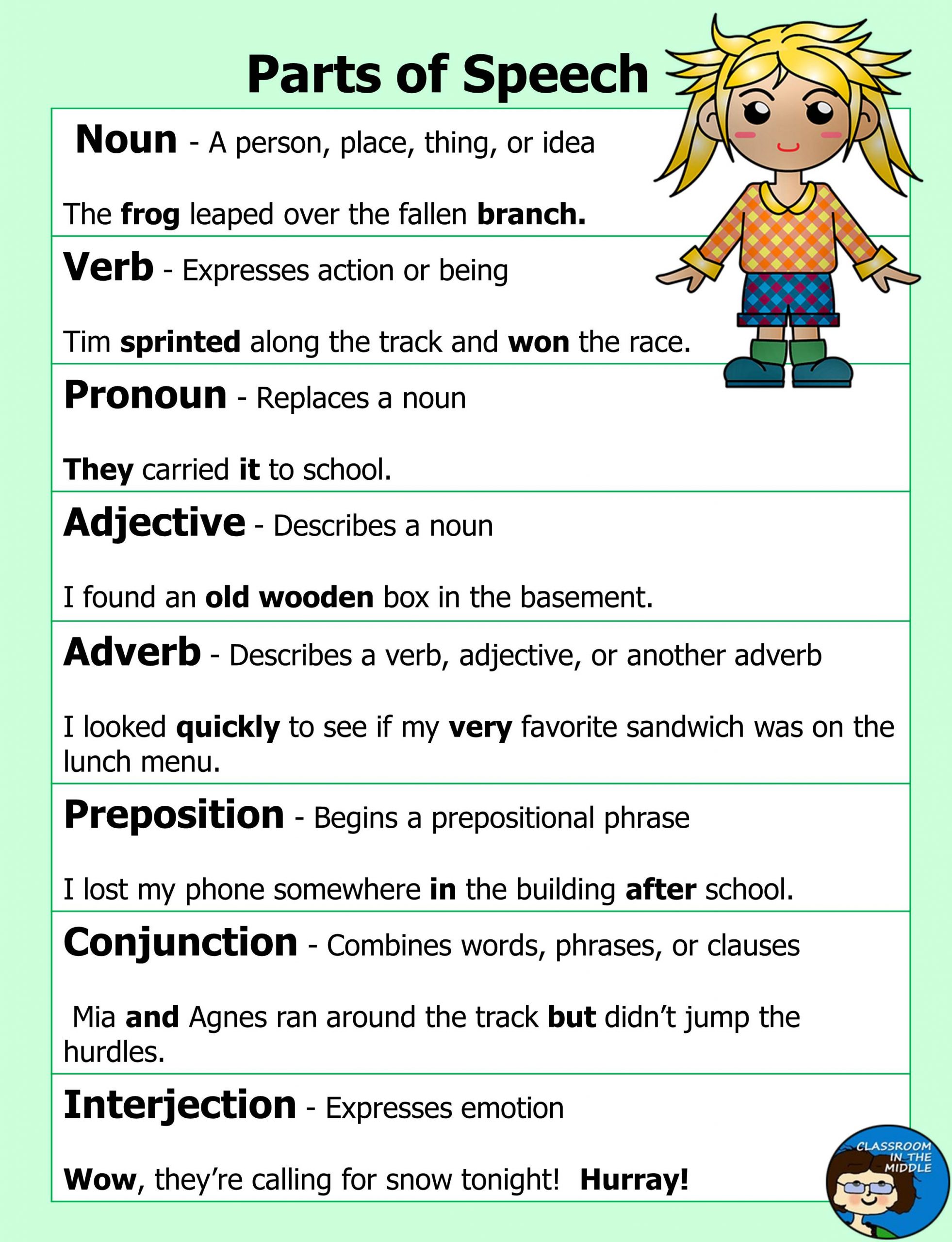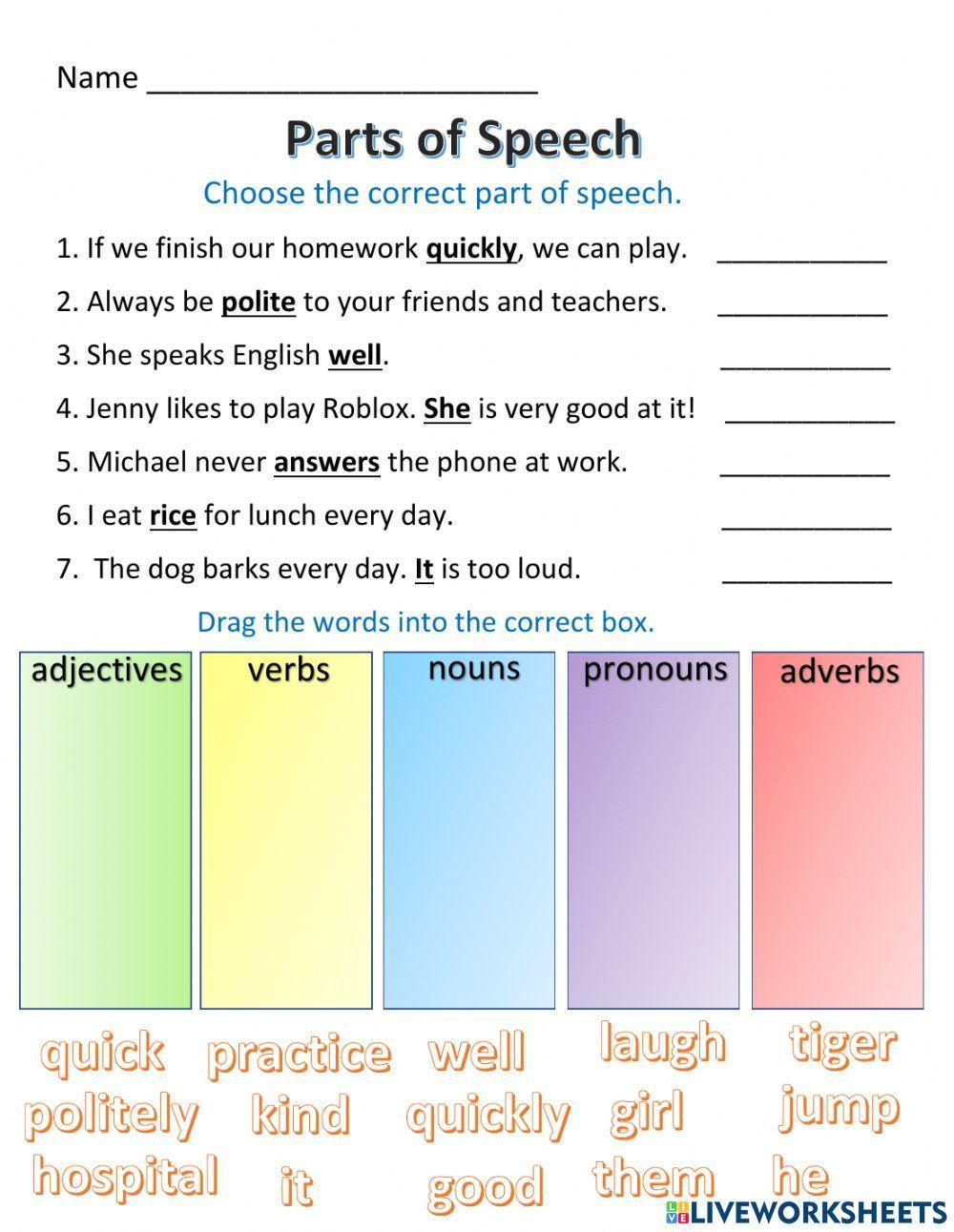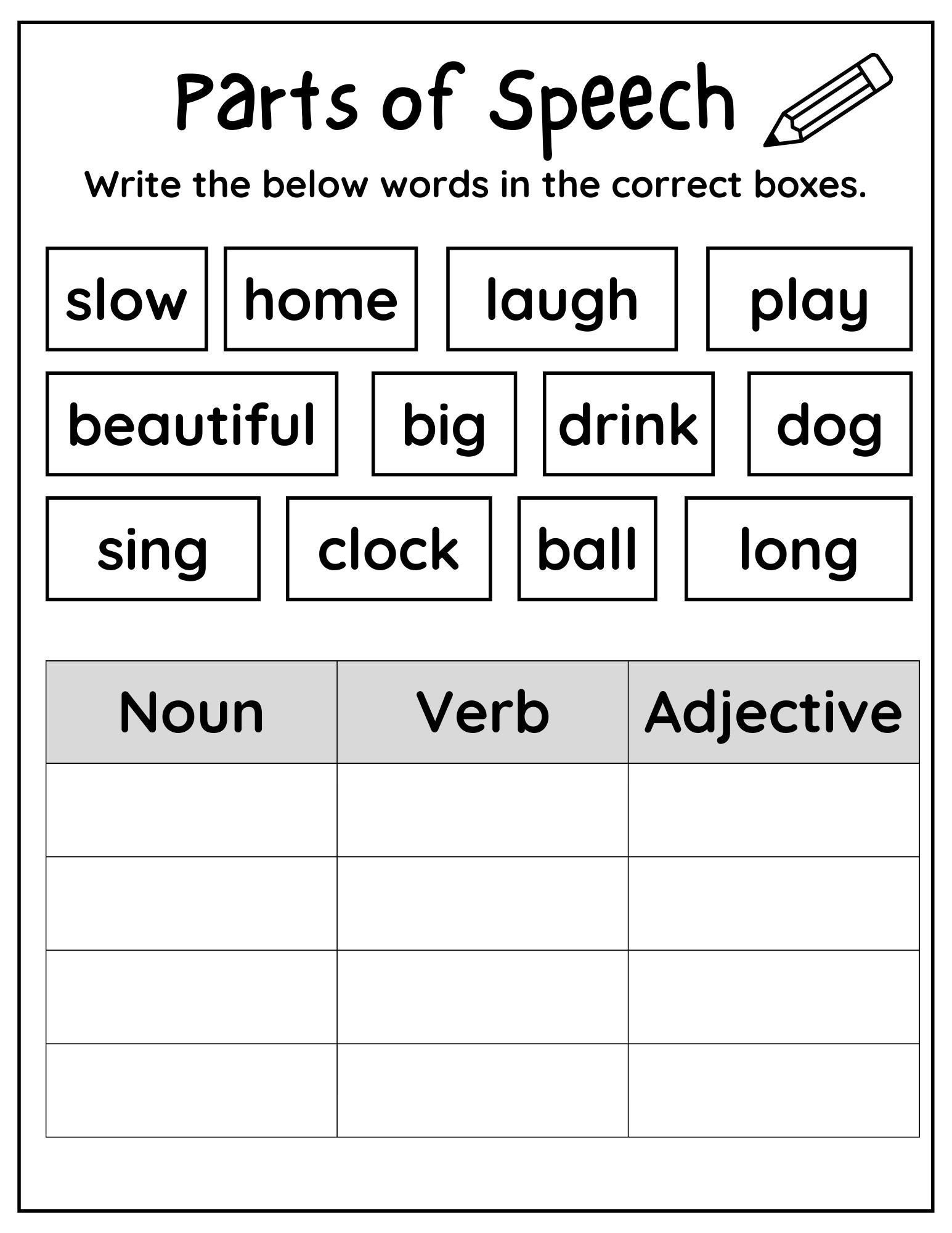
Unlocking Linguistic Mastery: The Power of Grammar Worksheets: Parts of Speech
Language, in all its fascinating complexity, is built upon a foundational structure, much like a magnificent edifice relies on sturdy bricks. These fundamental building blocks are the "parts of speech"—the categories that words fall into based on their function within a sentence. Mastering these categories is not merely an academic exercise; it is the cornerstone of clear communication, precise writing, and profound understanding of any language. For many learners, however, the abstract nature of grammar can be daunting. This is where the practical, hands-on approach of Grammar Worksheets: Parts of Speech becomes an invaluable tool, transforming abstract concepts into tangible, workable knowledge.
The Foundation: Understanding the Eight Parts of Speech

Before delving into the benefits and effective use of worksheets, it’s crucial to briefly revisit the eight primary parts of speech. Each plays a distinct role, contributing to the meaning and structure of every sentence we utter or write:

- Nouns: These are words that name a person, place, thing, or idea (e.g., student, London, book, happiness). They can be common (girl), proper (Sarah), concrete (table), or abstract (freedom).
- Pronouns: Words that replace nouns to avoid repetition (e.g., he, she, it, they, we, us, them, myself, who). They ensure fluidity and conciseness in language.
- Verbs: These are action words or states of being (e.g., run, think, is, seems, become). Verbs are the engine of a sentence, indicating what the subject does or what state it is in.
- Adjectives: Words that describe or modify nouns and pronouns, providing more information about their qualities (e.g., blue, tall, intelligent, delicious).
- Adverbs: Words that modify verbs, adjectives, or other adverbs, telling us how, when, where, why, or to what extent an action occurs or a quality exists (e.g., quickly, yesterday, here, very).
- Prepositions: Words that show the relationship between a noun or pronoun and other words in a sentence, often indicating position, direction, or time (e.g., in, on, under, with, during, before).
- Conjunctions: Words that connect words, phrases, clauses, or sentences (e.g., and, but, or, so, because, while). They are the linguistic glue that binds ideas together.
- Interjections: Words or phrases that express strong emotion or sudden feeling, often standing alone or at the beginning of a sentence (e.g., Wow!, Ouch!, Oh dear!).





Understanding these distinct roles is the first step. The next, and arguably most critical, is to be able to identify them in context and apply this knowledge practically. This is precisely where the utility of Grammar Worksheets: Parts of Speech shines brightest.
Why Parts of Speech Are Indispensable for Language Mastery

The significance of mastering parts of speech extends far beyond simple identification. They are the scaffolding upon which all other grammatical concepts are built:
- Sentence Structure (Syntax): Knowing parts of speech allows learners to understand how words combine to form coherent phrases, clauses, and sentences. It clarifies subject-verb agreement, direct and indirect objects, and the placement of modifiers.
- Clarity and Precision: Choosing the right part of speech (e.g., an adjective versus an adverb) can drastically alter meaning. Understanding their function enables writers to be precise, avoiding ambiguity and conveying their exact message.
- Reading Comprehension: When reading, identifying parts of speech helps unlock the meaning of complex sentences. It allows readers to discern who is doing what, to whom, and under what circumstances.
- Vocabulary Expansion: Understanding how different word forms (e.g., a noun like "beauty," an adjective "beautiful," an adverb "beautifully") are derived from a root word enhances vocabulary acquisition and usage.
- Foundation for Advanced Grammar: Concepts like verb tenses, voice (active/passive), parallelism, and complex sentence construction are impossible to grasp without a firm understanding of the fundamental parts of speech.
- Effective Communication: Ultimately, a solid grasp of parts of speech empowers individuals to express themselves more clearly, persuasively, and accurately, whether in academic writing, professional correspondence, or everyday conversation.

The Power of Practical Application: Why Grammar Worksheets?
While textbooks offer definitions and examples, they often fall short in providing the repetitive, hands-on practice necessary for true mastery. This is where Grammar Worksheets: Parts of Speech bridge the gap between theoretical knowledge and practical application.
Worksheets provide:
- Active Learning: Instead of passively reading, learners actively engage with the material, identifying, categorizing, and applying rules. This active participation enhances retention.
- Reinforcement and Repetition: Consistent practice through varied exercises solidifies understanding. Repetition helps move knowledge from short-term to long-term memory.
- Immediate Feedback: Many worksheets come with answer keys, allowing learners to check their work immediately, identify errors, and correct misunderstandings on the spot. This self-correction mechanism is highly effective.
- Identification of Weak Areas: By consistently making mistakes in a particular area (e.g., confusing adjectives and adverbs), learners and educators can pinpoint specific weaknesses that require more targeted practice.
- Customization and Differentiation: Worksheets can be tailored to different learning levels and styles. Simple identification exercises can progress to complex sentence analysis, catering to beginners and advanced learners alike.
- Structured Practice: They break down the vastness of grammar into manageable, bite-sized tasks, making the learning process less intimidating and more achievable.
- Engagement: Well-designed worksheets, incorporating interesting sentences, themed content, or even gamified elements, can make grammar practice enjoyable rather than tedious.
Specifically, Grammar Worksheets: Parts of Speech offer focused drills that isolate each part of speech or challenge learners to differentiate between them within a given context. This targeted approach is crucial for building a strong foundation.
Designing and Utilizing Effective Grammar Worksheets: Parts of Speech
For educators creating these resources, or learners seeking out the best ones, several principles ensure maximum effectiveness:
For Educators/Worksheet Creators:
- Variety of Exercise Types: Don’t limit to simple identification. Include:
- Underlining/highlighting specific parts of speech.
- Filling in blanks with the correct part of speech.
- Writing original sentences using given words as specific parts of speech.
- Error identification and correction (e.g., "Identify the adverb used incorrectly").
- Categorizing lists of words.
- Gradual Difficulty: Start with isolated word identification, then move to words in simple sentences, then complex sentences, and finally paragraphs.
- Contextualized Sentences: Use complete, meaningful sentences rather than isolated words. This helps learners understand the function of the word in context, which is key.
- Clear Instructions and Examples: Ensure learners know exactly what to do. Provide a clear example for each exercise type.
- Answer Keys: Essential for self-correction and teacher grading.
- Engaging Content: Use sentences that are interesting, humorous, or related to topics learners can relate to. This increases motivation.
For Learners Utilizing Worksheets:
- Understand the Definitions First: Before attempting a worksheet, ensure you grasp the definition and basic function of each part of speech.
- Analyze in Context: Don’t just guess. Look at how the word is being used in the sentence. Does it describe a noun? Does it show action? Does it connect ideas?
- Use a Dictionary (Wisely): If unsure about a word’s primary function, a dictionary can help, but remember that many words can be different parts of speech depending on context (e.g., "run" can be a verb or a noun).
- Practice Regularly: Short, consistent practice sessions are more effective than infrequent, long ones.
- Don’t Fear Mistakes: Mistakes are learning opportunities. Analyze why an answer was incorrect and understand the correct reasoning.
- Review Corrected Work: Go over your answers, especially the ones you got wrong, to reinforce the correct understanding.
Beyond Identification: How Parts of Speech Enhance Writing and Communication
The ultimate goal of using Grammar Worksheets: Parts of Speech is not just to label words, but to empower learners to become more effective communicators. This foundational knowledge directly translates into superior writing and speaking skills:
- Richer Vocabulary Application: Knowing a word’s part of speech allows writers to choose the most precise and impactful word. For instance, instead of saying "The dog ran quickly," one might consider if "The dog darted" (stronger verb) or "The agile dog quickly pursued" (adjective + adverb) conveys the desired nuance.
- Varying Sentence Structure: Understanding how nouns, verbs, and modifiers combine enables writers to construct diverse sentence types, preventing monotonous prose and adding rhythm and flow.
- Conciseness and Economy of Words: A firm grasp of parts of speech helps eliminate redundant words and phrases, leading to more direct and powerful communication.
- Clarity and Cohesion: By correctly employing conjunctions, prepositions, and pronouns, writers can ensure their ideas flow logically and are easily understood by the reader.
- Persuasion and Impact: Strategic use of strong verbs, vivid adjectives, and precise adverbs can make writing more compelling and persuasive.
In essence, mastering Grammar Worksheets: Parts of Speech provides the grammatical literacy needed to dissect existing texts and construct original, impactful ones. It moves learners from simply recognizing words to understanding their intricate dance within a sentence, allowing them to choreograph their own linguistic masterpieces.
Conclusion
In the grand tapestry of language, parts of speech are the essential threads, and Grammar Worksheets: Parts of Speech are the looms that help us weave them together effectively. They offer a structured, practical, and engaging pathway to linguistic mastery. From the youngest learners taking their first steps in grammar to advanced students refining their writing, the systematic practice provided by these worksheets is indispensable. By investing time and effort in this foundational area, learners equip themselves not just with grammatical rules, but with the power to communicate with clarity, precision, and confidence, unlocking the full potential of language in all its forms.
